Transport Service Provider Perception of Barriers and Urban Freight Policies in Brazil
Abstract
1. Introduction
2. Literature Review
- (1)
- (2)
- (3)
- (4)
- (5)
- (6)
- (7)
- (1)
- (2)
- (3)
- (4)
- (1)
- (2)
- (3)
- (4)
- (5)
Urban Freight Transport and Stakeholders in Brazil
3. Research Approach
4. Results and Discussion
4.1. Barriers and Freight Restriction Analysis
4.2. Freight Policies Analysis
4.3. Discussion
5. Conclusions
Author Contributions
Funding
Acknowledgments
Conflicts of Interest
References
- Nathanail, E.; Adamosa, G.; Gogasa, M.A. novel approach for assessing sustainable city logistics. Transp. Res. Procedia 2017, 25, 1036–1045. [Google Scholar] [CrossRef]
- Behrends, S.; Lindholm, M.; Woxenius, J. The Impact of Urban Freight Transport: A Definition of Sustainability from an Actor’s Perspective. Transp. Plan. Technol. 2008, 31, 693–713. [Google Scholar] [CrossRef]
- Quak, H.; Balm, S.; Posthumus, B.; Bruening, M. Innovative Solutions for City Logistics: Demonstration and Viability Results. In Proceedings of the European Transport Conference 2012, Glasgow, UK, 8–10 October 2012. [Google Scholar]
- World Bank. Word Bank Open Data. 2018. Available online: https://data.worldbank.org (accessed on 15 December 2018).
- UN. Percentage of Population in Urban and Rural Areas in Brasil. United Nation 2018. World Urbanization Prospects 2018. Available online: https://population.un.org/wup/Country-Profiles/ (accessed on 15 December 2018).
- Dablanc, L. Goods transportation in large European cities: Difficult to organize, difficult to modernize. Transp. Res. Part A Policy Pract. 2007, 41, 280–285. [Google Scholar] [CrossRef]
- Dell’Olio, L.; Moura, J.L.; Ibeas, A.; Cordera, R.; Holguin-Veras, J. Receivers’ willingness-to-adopt novel urban goods distribution practices. Transp. Res. Part A Policy Pract. 2017, 102, 130–141. [Google Scholar] [CrossRef]
- Kin, B.; Verlinde, S.; Momments, K.; Macharis, C. A stakeholder-based methodology to enhance the success of urban freight transport measures in a multi-level governance context. Res. Transp. Econ. 2017, 65, 10–23. [Google Scholar] [CrossRef]
- Rødseth, K. Productivity growth in urban freight transport: An index number approach. Transp. Policy 2017, 56, 86–95. [Google Scholar] [CrossRef]
- Oliveira, L.K.; Barraza, B.; Bertoncini, B.V.; Isler, C.A.; Pires, D.R.; Madalon, E.C.; Lima, J.; Vieira, J.G.V.; Meira, L.H.; Bracarense, L.S.F.P.; et al. An overview of problems and solutions for urban freight transport in Brazilian cities. Sustainability 2018, 10, 1233. [Google Scholar] [CrossRef]
- Woudsma, C. Freight transportation: The evolving landscape of matters and models. In The Practice of Spatial Analysis: Essays in Memory of Professor Pavlos Kanaroglou; Briassoulis, H., Kavroudakis, D., Soulakellis, N., Eds.; Springer International Publishing: New York, USA, 2019; pp. 189–202. [Google Scholar] [CrossRef]
- Lindholm, M. A sustainable perspective on urban freight transport: Factors affecting local authorities in the planning procedures. Procedia Soc. Behav. Sci. 2010, 2, 6205–6216. [Google Scholar] [CrossRef]
- Ducret, R.; Gonzalez-Feliu, J. Connecting demand estimation and spatial category models for urban freight: First attempt and research implications. Transp. Res. Procedia 2016, 12, 142–156. [Google Scholar] [CrossRef]
- Ducret, R.; Lemarié, B.; Roset, A. Cluster analysis and spatial modeling for urban freight. Identifying homogeneous urban zones based on urban form and logistics characteristics. Transp. Res. Procedia 2016, 12, 301–312. [Google Scholar] [CrossRef]
- Castro, R.B.; Merchán, D.; Lima, O.F., Jr.; Winkenbach, M. City Logistics and Clustering: Impacts of Using HDI and Taxe. In City Logistics 2: Modeling and Planning Initiatives; Taniguchi, E., Thompson, R.G., Eds.; ISTE Ltd and John Wiley & Sons: London, UK, 2018; pp. 131–141. [Google Scholar] [CrossRef]
- Lindawati, J.S.; Goh, M.; Souza, R. Collaboration in urban logistics: Motivations and barriers. Int. J. Urban Sci. 2014, 18, 278–290. [Google Scholar] [CrossRef]
- Toilier, F.; Serouge, M.; Routhier, J.-P.; Patier, D.; Gardrat, M. How can urban goods movements be surveyed in a megacity? The case of the Paris region. Transp. Res. Procedia 2016, 12, 570–583. [Google Scholar] [CrossRef]
- Lu, F.; Zhao, F.; Cheah, L. Dimensionality Reduction to Reveal Urban Truck Driver Activity Patterns. Transp. Res. Rec. J. Transp. Res. Board 2018, 2672, 81–82. [Google Scholar] [CrossRef]
- Carvalho, P.P.S.; Kalid, R.A.; Rodríguez, J.L.M.; Santiago, S.B. Interactions among stakeholders in the processes of city logistics: A systematic review of the literature. Scientometrics 2019, 120, 567–607. [Google Scholar] [CrossRef]
- Marcucci, E.; Gatta, V.; Scaccia, L. Urban freight, parking and pricing policies: An evaluation from a transport provider’s perspective. Transp. Res. Part A Policy Pract. 2015, 74, 239–249. [Google Scholar] [CrossRef]
- Nordtømme, M.E.; Bjerkan, K.Y.; Sund, A.B. Barriers to urban freight policy implementation: The case of urban consolidation center in Oslo. Transp. Policy 2015, 44, 179–186. [Google Scholar] [CrossRef]
- Holguín-Veras, J.; Leal, J.A.; Seruya, B.B. Urban freight policy making: The role of qualitative and quantitave research. Transp. Policy 2017, 56, 75–85. [Google Scholar] [CrossRef]
- Le Pira, M.; Marcucci, E.; Gatta, V.; Ignacoolo, M.; Pluchino, A. Towards a decision-support procedure to foster stakeholder involvement and acceptability of urban freight transport policies. Eur. Transp. Res. Rev. 2017, 9, 54. [Google Scholar] [CrossRef]
- Oliveira, G.F.; Oliveira, L.K. Stakeholder’s perception about urban goods distribution solution: Exploratory study in Belo Horizonte (Brazil). Transp. Res. Procedia 2017, 25, 942–953. [Google Scholar] [CrossRef]
- Rai, H.B.; van Lier, T.; Meers, D.; Macharis, C. Improving urban freight transport sustainability: Policy assessment framework and case study. Res. Transp. Econ. 2017, 64, 26–35. [Google Scholar] [CrossRef]
- Dias, J.M.; Sobanksi, G.B.; Silva, J.E.A.R.; Oliveira, L.K.; Vieira, J.J.V. Are Brazilian cities ready to develop an efficient urban freight mobility plan? URBE Rev. Bras. De Gestão Urbana (Braz. J. Urban Manag.) 2018, 10, 587–599. [Google Scholar] [CrossRef]
- Duin, R.V.; Slabbekoorn, M.; Tavasszy, L.; Quak, H. Identifying dominant stakeholder perspectives on urban freight policies: A q-analysis on urban consolidation centres in The Netherlands. Transport 2018, 33, 867–880. [Google Scholar] [CrossRef]
- Furquim, T.S.G.; Vieira, J.G.V.; Oliveira, R.L.M. Restrições de carga urbana e desafios logísticos: Percepção de varejistas e motoristas de Sorocaba. Transportes 2018, 26, 142–156. [Google Scholar] [CrossRef][Green Version]
- Lebeau, P.; Macharis, C.; Mierlo, J.V.; Janjevic, M. Improving policy support in city logistics: The contributions of a multi-actor multi-criteria analysis. Case Stud. Transp. Policy 2018, 6, 554–563. [Google Scholar] [CrossRef]
- Oliveira, L.K.; Souza, P.R.; Resende, P.T.V.; Oliveira, R.B.; Oliveira, R.L.M. Viewpoint of industries, retailers and carriers about urban freight transport: Solutions, challenges and practices in Brazil. In City Logistics I: New Opportunities and Challenges; Taniguchi, E., Thompson, R.G., Eds.; ISTE Ltd and John Wiley & Sons: London, UK, 2018; pp. 287–302. [Google Scholar] [CrossRef]
- Aljohani, K.; Thompson, R.G. A Stakeholder-Based Evaluation of the Most Suitable and Sustainable Delivery Fleet for Freight Consolidation Policies in the Inner-City Area. Sustainability 2019, 11, 124. [Google Scholar] [CrossRef]
- Akgün, E.Z.; Monios, J.; Rye, T.; Fonzone, A. Influences on urban freight transport policy choice by local authorities. Transp. Policy 2019, 75, 88–98. [Google Scholar] [CrossRef]
- Gatta, V.; Site, P.D.; Le Pira, M.; Carrocci, C.S. Planning with stakeholders: Analysing alternative off-hour delivery solutions via an interactive multi-criteria approach. Res. Transp. Econ. 2019, 73, 53–62. [Google Scholar] [CrossRef]
- Semanjski, I.; Gautama, S. A Collaborative Stakeholder Decision-Making Approach for Sustainable Urban Logistics. Sustainability 2019, 11, 234. [Google Scholar] [CrossRef]
- Oliveira, L.K.; Sousa, L.T.M.; Nascimento, C.O.L.; Silva, T.G.C.; Pinto, P.H.G.; Garcia, M.N.; Farias, L.P.; Ferreira, S.; Oliveira, R.L.M.; Jesus, M.C.R.; et al. Sustainable City Logistics Planning: Methods and Applications, Volume 2; Awasthi, A., Ed.; Nova Science Publishers: New York, NY, USA, 2020. [Google Scholar]
- Marcucci, E.; Le Pira, M.; Gatta, E.; Inturri, G.; Ignacoolo, M.; Pluchino, A. Simulating participatory urban freight transport policy-making: Accounting for heterogeneous stakeholders’ preference and interaction effects. Transp. Res. Part E Logist. Transp. Rev. 2017, 103, 69–86. [Google Scholar] [CrossRef]
- Marcucci, E.; Gatta, V.; Le Pira, M. Gamification design to foster stakeholder engagement and behavior change: An application to urban freight transport. Transp. Res. Part A 2018, 118, 119–132. [Google Scholar] [CrossRef]
- Bean, W.L.; Joubert, J.W. A systematic evaluation of freight carrier response to receiver reordering behaviour. Comput. Ind. Eng. 2018, 124, 207–219. [Google Scholar] [CrossRef]
- Russo, F.; Comi, A. Urban freight transport planning towards green goals: Synthetic environmental evidence from tested results. Sustainability 2016, 8, 381. [Google Scholar] [CrossRef]
- Brasil Law 12,587 from 3 January 2012. Available online: http://www.planalto.gov.br/ccivil_03/_Ato2011-2014/2012/Lei/L12587.htm (accessed on 30 October 2019).
- Prata, B.A.; Oliveira, L.K.; Holanda, T.C. Locating on-street loading and unloading spaces by means of mixed integer programming. Transportes 2018, 26, 16–29. [Google Scholar] [CrossRef]
- Jaller, M.; Holguín-Veras, J.; Hodge, S. Parking in the City: Challenges for Freight Traffic. Transp. Res. Rec. J. Transp. Res. Board 2014, 2379, 46–56. [Google Scholar] [CrossRef]
- Allen, J.; Browne, M.; Woodburn, A.; Leonardi, J. The role of urban consolidation centres in sustainable freight transport. Transp. Rev. 2012, 32, 473–490. [Google Scholar] [CrossRef]
- Allen, J.; Browne, M.; Woodburn, A.; Leonardi, J. A review of urban consolidation centres in the supply chain based on a case study approach. Supply Chain Forum Int. J. 2014, 15, 100–112. [Google Scholar] [CrossRef]
- Browne, M.; Allen, J.; Leonardi, J. Evaluating the use of an urban consolidation centre and electric vehicles in central London. IATSS Res. 2011, 35, 1–6. [Google Scholar] [CrossRef]
- Russo, F.; Comi, A. A classification of city logistics measures and connected impacts. Procedia Soc. Behav. Sci. 2010, 2, 6355–6365. [Google Scholar] [CrossRef]
- Duin, J.H.R.; Tavasszy, L.A.; Quak, H.J. Towards E(lectric)-urban freight: First promising steps in the electric vehicle revolution. Trasp. Eur. 2013, 54, 1–19. [Google Scholar]
- Taefi, T.T.; Fink, A.; Kreutzfeldt, J.; Held, T. On the profitability of electric vehicles in urban freight transport. In Proceedings of the European Operations Management Association, Dublin, Ireland, 7–12 June 2013. [Google Scholar]
- Balm, S.; Moolenburgh, E.; Anand, N.; Ploos van Amstel, W. The Potential of Light Electric Vehicles for Specific Freight Flows: Insights from the Netherlands. In City Logistics 2: Modeling and Planning Initiatives; Taniguchi, E., Thompson, R.G., Eds.; ISTE Ltd: London, UK, 2018; pp. 241–260. [Google Scholar] [CrossRef]
- Rizet, C.; Cruz, C.; Vromant, M. The constraints of vehicle range and congestion for the use of electric vehicles for urban freight in France. Transp. Res. Procedia 2016, 12, 500–507. [Google Scholar] [CrossRef]
- Lenz, B.; Riehle, E. Bikes for urban freight? Experience in Europe. Transp. Res. Rec. 2013, 2379, 39–45. [Google Scholar] [CrossRef]
- Gruber, J.; Kihm, A.; Lenz, B. A new vehicle for urban freight? An ex-ante evaluation of electric cargo bikes in courier services. Res. Transp. Bus. Manag. 2014, 11, 53–62. [Google Scholar] [CrossRef]
- Riggs, W. Cargo bikes as a growth area for bicycle vs. auto trips: Exploring the potential for mode substitution behavior. Transp. Res. Part F Traffic Psychol. Behav. 2016, 43, 48–55. [Google Scholar] [CrossRef]
- Schliwa, G.; Armitage, R.; Aziz, S.; Evans, J.; Rhoades, J. Sustainable city logistics—Making cargo cycles viable for urban freight transport. Res. Transp. Bus. Manag. 2015, 15, 50–57. [Google Scholar] [CrossRef]
- Rudra, M.; Roorda, M. Truck-only lanes on urban arterials: A value of time approach. Procedia Soc. Behav. Sci. 2014, 125, 75–83. [Google Scholar] [CrossRef][Green Version]
- Holguín-Veras, J.; Wang, X.; Sánchez-Díaz, I.; Campbell, S.; Hodge, S.D.; Jaller, M.; Wojtowicz, J. Fostering unassisted off-hour deliveries: The role of incentives. Transp. Res. Part A 2017, 102, 172–187. [Google Scholar] [CrossRef]
- Mommens, K.; Lebeau, P.; Verlinde, S.; Lier, T.; Macharis, C. Evaluating the impact of off-hour deliveries: An application of the Transport Agent-Based model. Transp. Res. Part D Transp. Environ. 2018, 62, 102–111. [Google Scholar] [CrossRef]
- Verlinde, S.; Macharis, C. Who is in favor of off-hour deliveries to Brussels supermarkets? Applying Multi Actor Multi Criteria analysis (MAMCA) to measure stakeholder support. Transp. Res. Procedia 2016, 12, 522–532. [Google Scholar] [CrossRef]
- Bomtempo, A.P.; Cunha, C.B.; Botter, D.A.; Yoshizaki, H.T.Y. Evaluating Restrictions on the Circulation of Freight Vehicles in Brazilian Cities. Procedia Soc. Behav. Sci. 2014, 125, 275–283. [Google Scholar] [CrossRef]
- Dablanc, L.; Montenon, A. Impacts of Environmental Access Restrictions on Freight Delivery Activities. Transp. Res. Rec. J. Transp. Res. Board 2015, 2478, 12–18. [Google Scholar] [CrossRef]
- Rotaris, L.; Danielis, R.; Marcucci, E.; Massiani, J. The urban road pricing scheme to curb pollution in Milan, Italy: Description, impacts and preliminary cost–benefit analysis assessment. Transp. Res. Part A Policy Pract. 2010, 44, 359–375. [Google Scholar] [CrossRef]
- Morganti, E.; Dablanc, L.; Fortin, F. Final deliveries for online shopping: The deployment of pickup point networks in urban and suburban areas. Res. Transp. Bus. Manag. 2014, 11, 23–31. [Google Scholar] [CrossRef]
- Oliveira, L.K.; Oliveira, R.L.M.; Sousa, L.T.M.; Caliari, I.P.; Nascimento, C.O.L. Analysis of accessibility from collection and delivery points: Towards the sustainability of the e-commerce delivery. URBE Rev. Bras. De Gestão Urbana 2019, 11, e20190048. [Google Scholar] [CrossRef]
- Cohen, B.; Munoz, P. Sharing cities and sustainable consumption and production: Towards an integrated framework. J. Clean. Prod. 2016, 134, 87–97. [Google Scholar] [CrossRef]
- Tavakol, M.; Dennick, R. Making sense of Cronbach’s alpha. Int. J. Med Educ. 2011, 2, 53–55. [Google Scholar] [CrossRef]
- Friendly, M. Corrgrams: Exploratory displays for correlation matrices. Am. Stat. 2002, 56, 316–324. [Google Scholar] [CrossRef]
- Kulik, V.; Sossa, R. Determining the tourist attractive regions by GIS analysis using heatmaps. Geod. Cartogr. 2018, 44, 22–27. [Google Scholar] [CrossRef]
- Kaiser, H.F. An index of factor simplicity. Psychometrika 1974, 39, 31–36. [Google Scholar] [CrossRef]
- Kaiser, H.F. A Note on Guttman’s Lower Bound for the Number of Common Factors. Br. J. Stat. Psychol. 1961, 14, 1–2. [Google Scholar] [CrossRef]
- Jollife, I.T. Principal Component Analysis; Springer: New York, NY, USA, 2002. [Google Scholar]
- Peres-Neto, P.R.; Jackson, D.A.; Somers, K.M. How Many Principal Components? Stopping Rules for Determining the Number of Non-Trivial Axes Revisited. Br. J. Stat. Psychol. 2005, 49, 974–997. [Google Scholar] [CrossRef]
- Pomerol, J.-C.; Barba-Romero, S. Multicriterion Decision in Management: Principles and Practice; Springer: New York, NY, USA, 2018. [Google Scholar]
- Wright, K. Package “Corrgram”. 2018. Available online: https://cran.r-project.org/web/packages/corrgram/corrgram.pdf (accessed on 15 July 2019).
- Revelle, W. Package “Psych”: Procedures for Psychological, Psychometric, and Personality Research. 2018. Available online: https://cran.r-project.org/web/packages/psych/psych.pdf (accessed on 30 October 2019).
- Venables, W.N.; Ripley, B.D. Modern Applied Statistics with S; Springer: New York, NY, USA, 2002. [Google Scholar]
- Husson, F.; Josse, J.; Le, S.; Mazet, J. FactoMineR: Multivariate Exploratory Data Analysis and Data Mining. 2018. Available online: https://cran.r-project.org/web/packages/FactoMineR/FactoMineR.pdf (accessed on 15 July 2019).
- Gavião, L.O.; Sant’Anna, A.P.; Lima, G.B.A.; Garcia, P.A.A. Composition of Probabilistic Preferences (CPP). Version 0.1.0. Available online: https://cran.r-project.org/web/packages/CPP/CPP.pdf (accessed on 30 October 2019).
- Gliem, J.A.; Gliem, R.R. Calculating, Interpreting, and Reporting Cronbach’s Alpha Reliability Coefficient for Likert-Type Scales. In Proceedings of the 2003 Midwest Research to Practice Conference in Adult, Continuing, and Community Education, Columbus, OH, USA, 7–12 June 2003. [Google Scholar]
- Campbell, S.; Holguín-Veras, J.; Ramirez-Rios, D.G.; González-Calderón, C.; Kalahasthi, L.; Wojtowicz, J. Freight and service parking needs and the role of demand management. Eur. Transp. Res. Rev. 2018, 10, 47. [Google Scholar] [CrossRef]
- Matusiewicz, M. Towards Sustainable Urban Logistics: Creating Sustainable Urban Freight Transport on the Example of a Limited Accessibility Zone in Gdansk. Sustainability 2019, 11, 3879. [Google Scholar] [CrossRef]
- Vukovic, N.; Rzhavtsev, A.; Shmyrev, V. Smart city: The case study of Saint-Peterburg. Int. Rev. 2019, 1–2, 15–20. [Google Scholar]
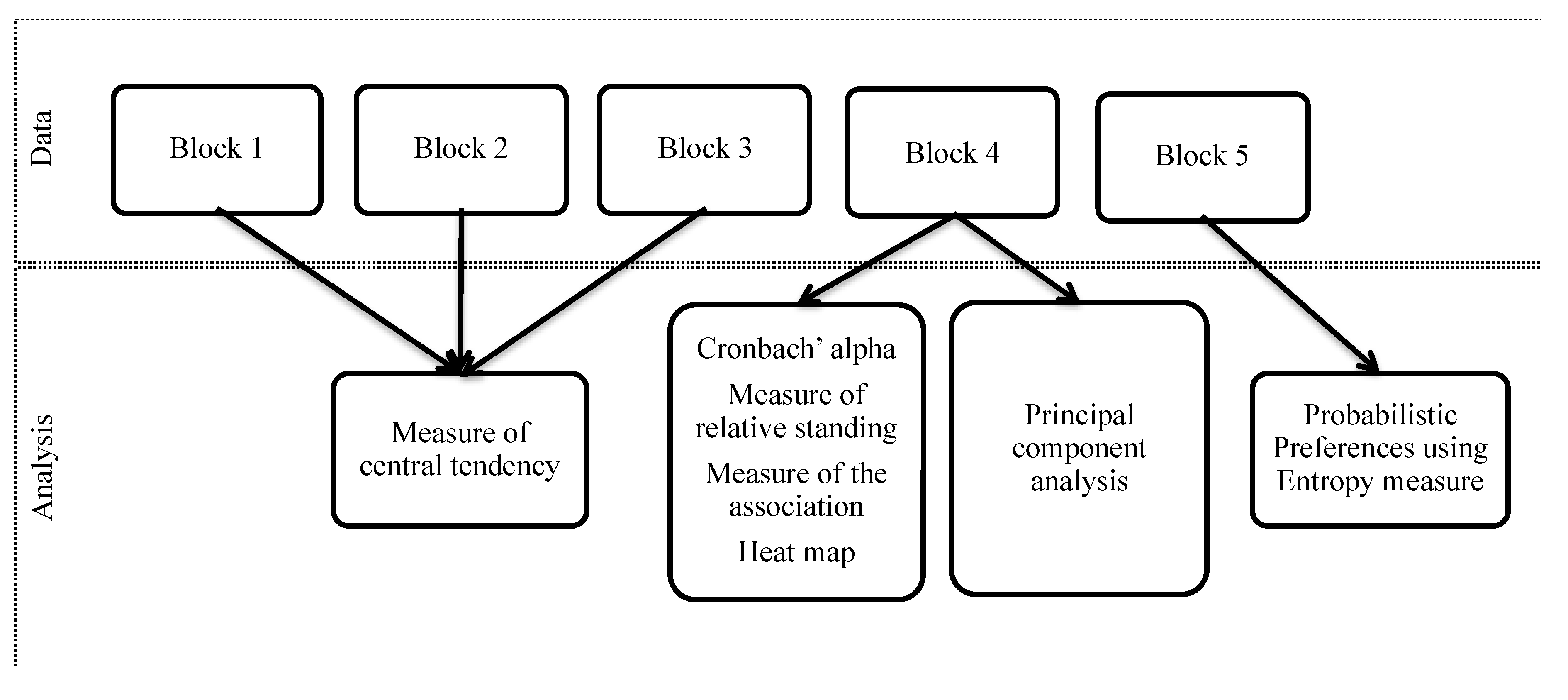
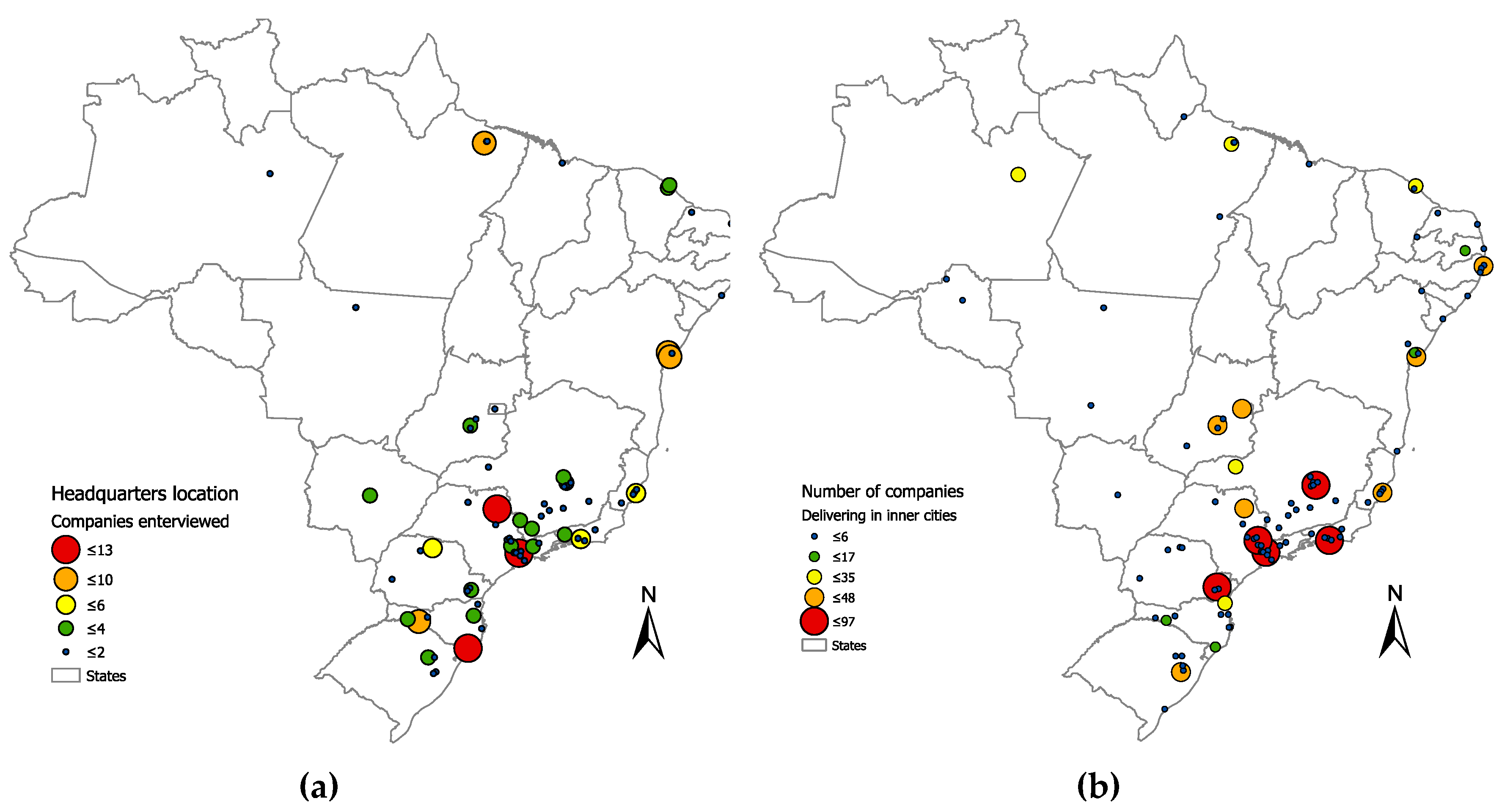
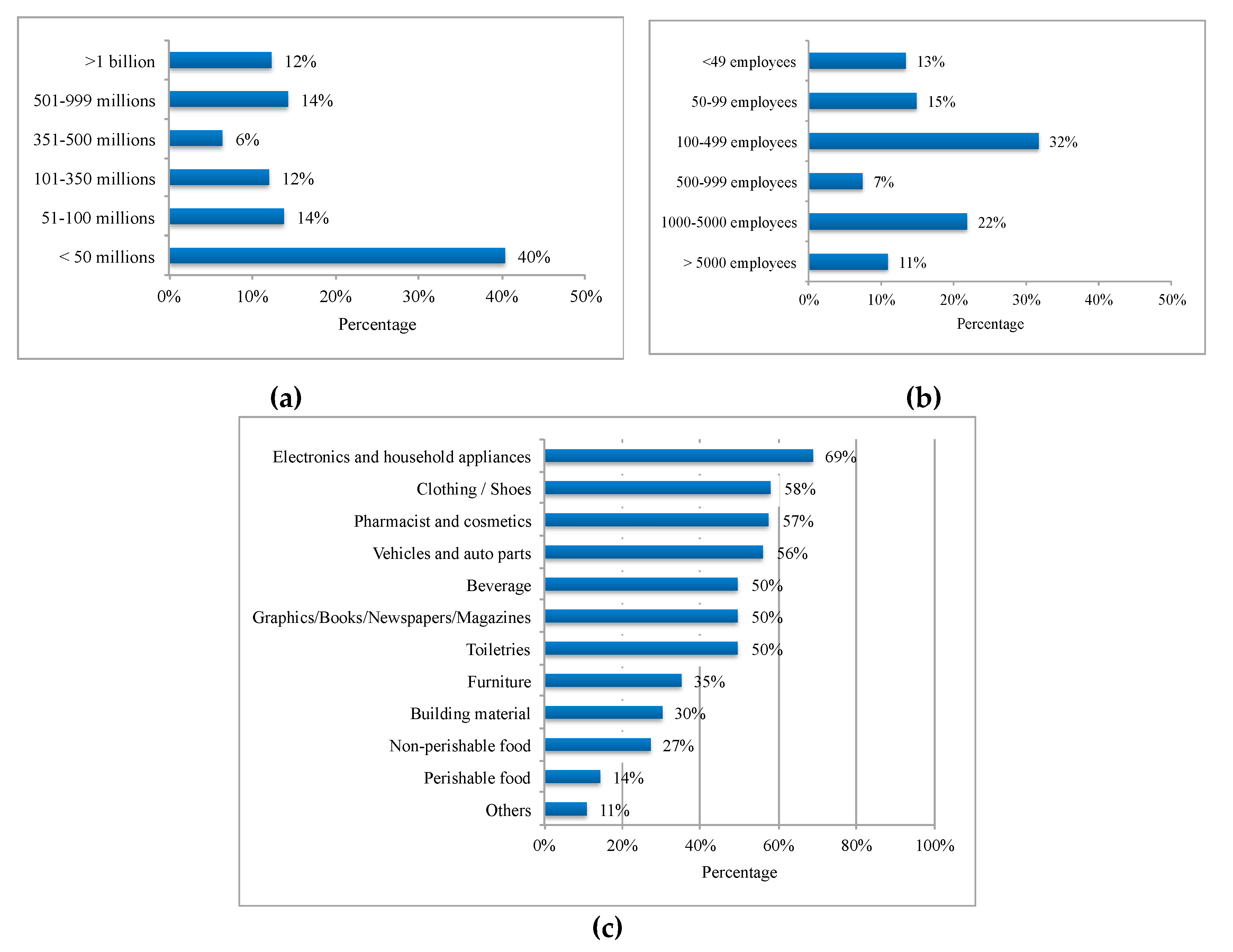
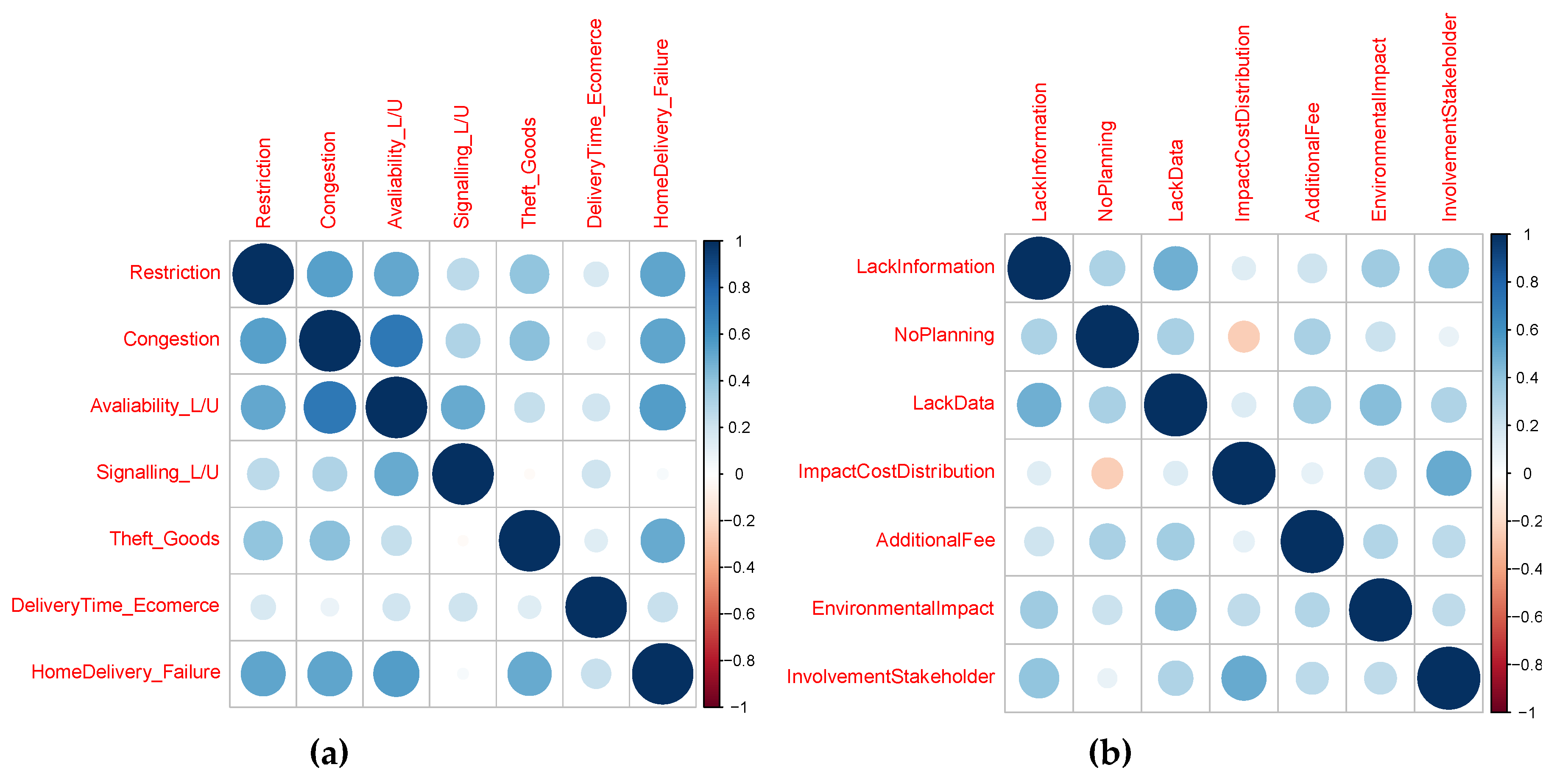
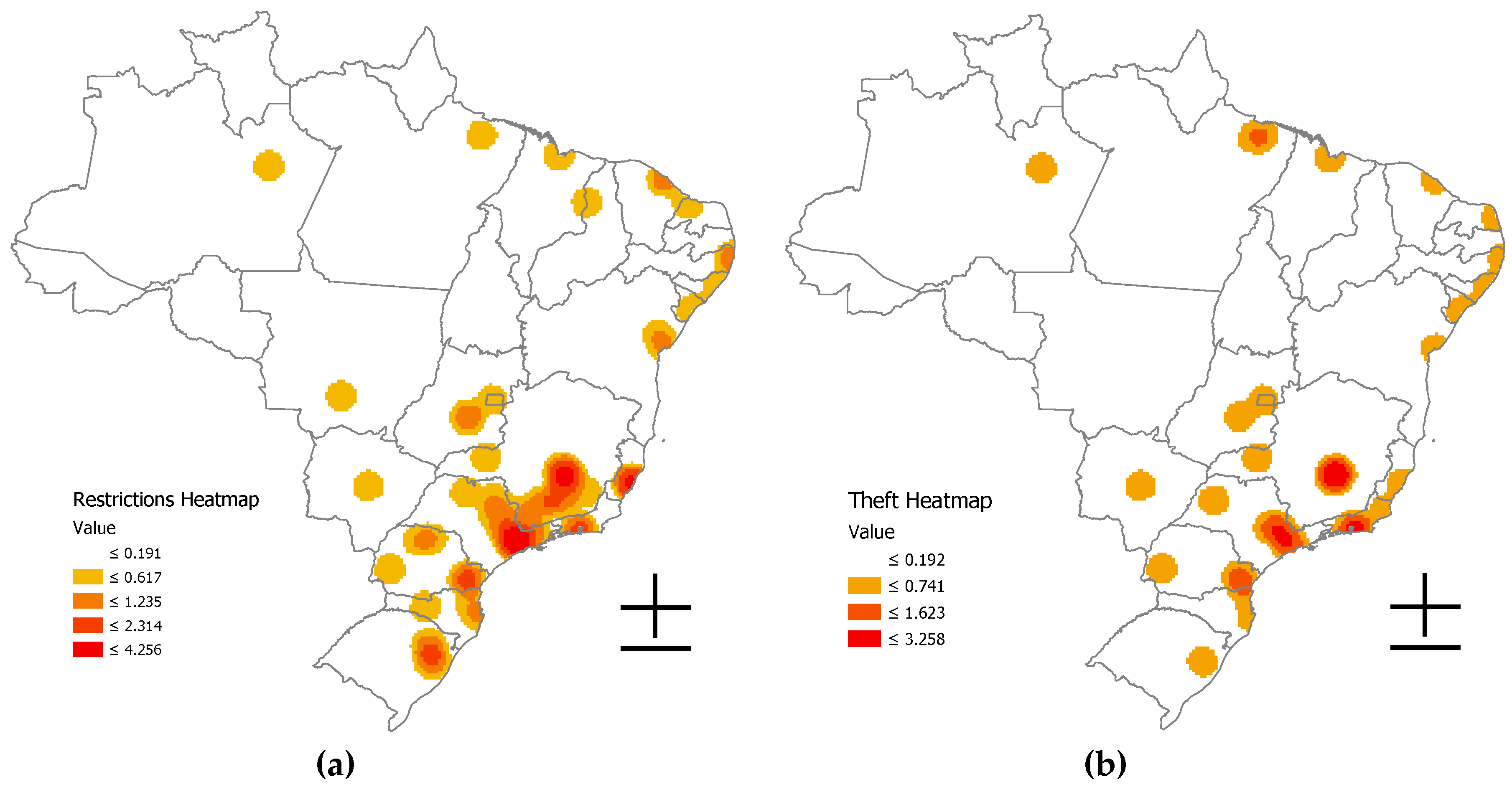
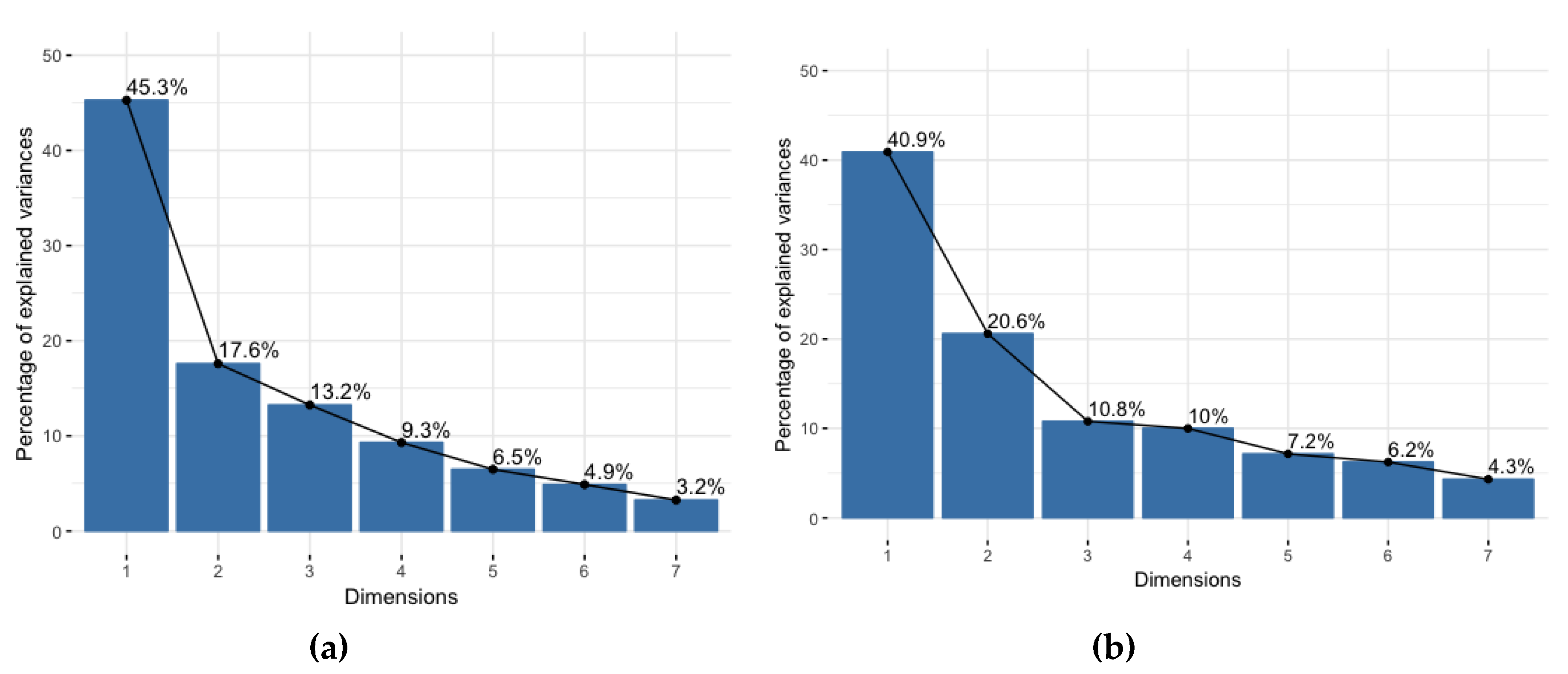
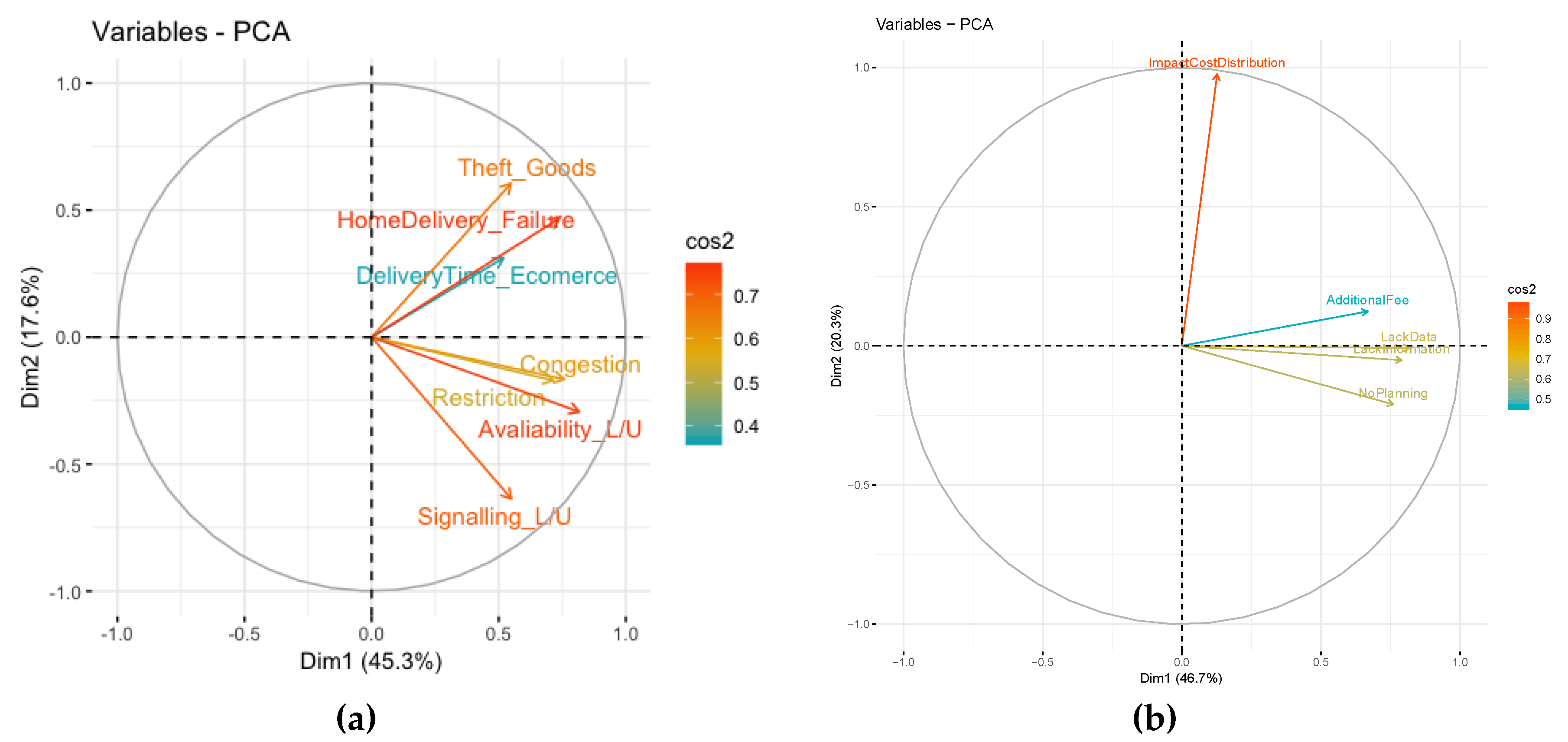
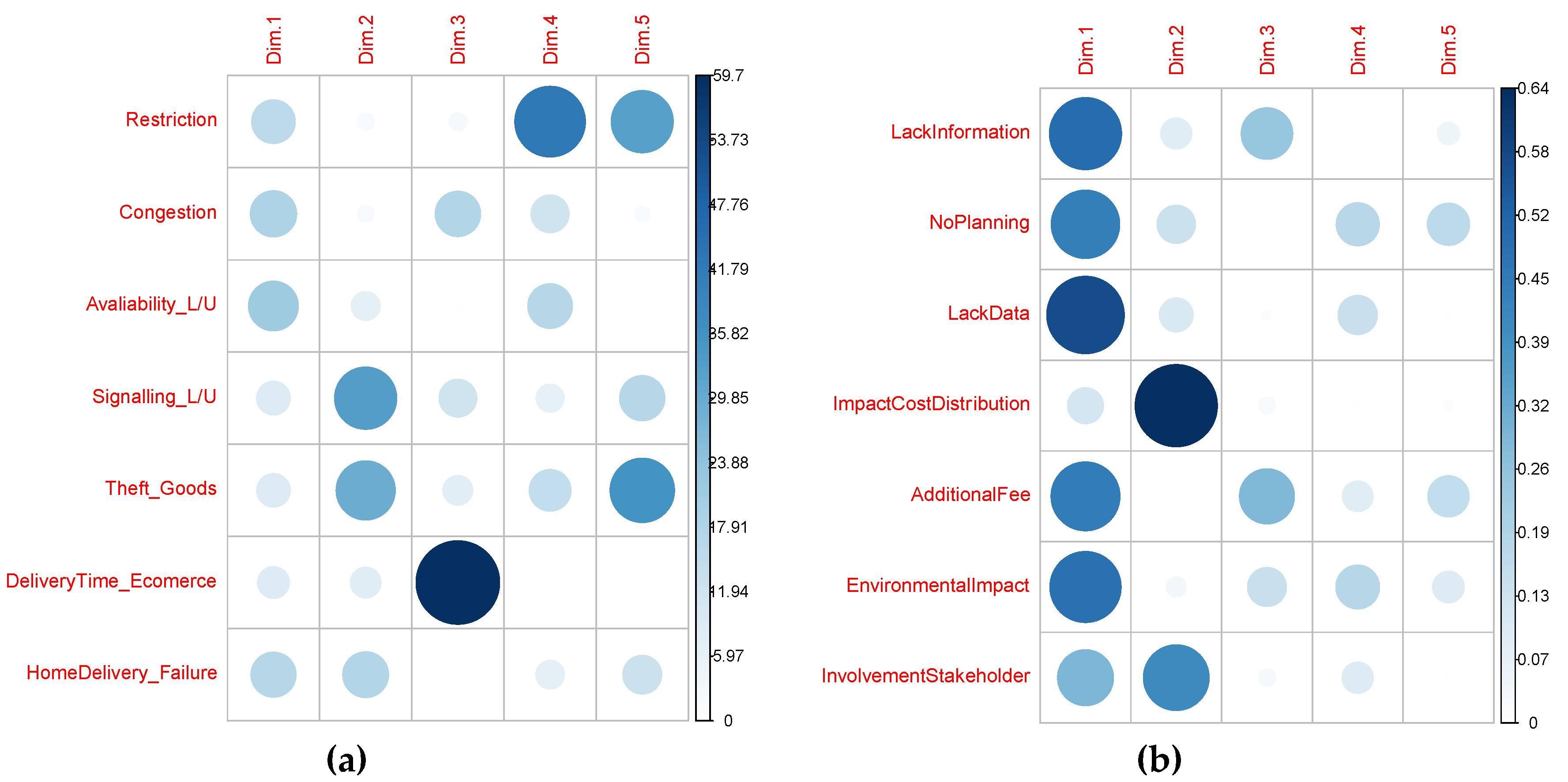
| Block | Theme | Variable | Response Type |
|---|---|---|---|
| Block 1 | Company information | City/state | Text |
| Gross sales | Categorical (10 classes) | ||
| Number of employers | Continuous | ||
| Block 2 | Urban delivery | City | Categorical (19 classes) |
| Type of vehicles | Categorical (6 classes) | ||
| Main class of product delivered | Categorical (10 classes) | ||
| Fleet owner | Categorical (3 classes) | ||
| Block 3 | E-commerce deliveries | % home deliveries | Continuous |
| % failure home deliveries | Continuous | ||
| Alternative from home deliveries | Categorical (3 classes) | ||
| Block 4 | Barriers | Restriction of freight vehicles Congestion Availability of loading/unloading areas Signaling of loading/unloading areas Theft of goods Delivery time from e-commerce products Home deliveries failure | Likert scale |
| Freight restriction barriers | Lack of information No planning procedure Lack of data Impact on the distribution cost Implementation of an additional fee Environmental impact Involvement of stakeholders | Likert scale | |
| Block 5 | Urban freight policies | Urban mobility plan Guidelines to loading/unloading areas Booking loading/unloading areas in advance Mini-hubs in urban areas Electric vehicles Cargo bikes Truck lanes Off-peak delivery Freight vehicle restriction Congestion charge to freight vehicles Pick-up points or lockers Collaborative delivery | Ranking |
| Theme | Variable | Min | 1st Qu. | Median | 3rd Qu. | Max | Cronbach’s Alpha |
|---|---|---|---|---|---|---|---|
| Barriers | Restriction of freight vehicles | 1 | 5 | 5 | 5 | 5 | 0.72 |
| Congestion | 3 | 5 | 5 | 5 | 5 | 0.72 | |
| Availability of loading/unloading areas | 3 | 5 | 5 | 5 | 5 | 0.70 | |
| Signalling of loading/unloading areas | 1 | 4 | 4 | 4 | 5 | 0.75 | |
| Theft of goods | 3 | 5 | 5 | 5 | 5 | 0.74 | |
| Delivery time of e-commerce products | 1 | 4 | 4 | 4 | 5 | 0.74 | |
| Home delivery failures | 1 | 5 | 5 | 5 | 5 | 0.73 | |
| Freight restriction measure | Lack of information | 1 | 4 | 4 | 4 | 5 | 0.71 |
| No planning process | 1 | 5 | 5 | 5 | 5 | 0.72 | |
| Lack of data | 1 | 4 | 4 | 4 | 5 | 0.70 | |
| Impact on the distribution cost | 1 | 4 | 4 | 4 | 5 | 0.76 | |
| Additional fee | 1 | 4 | 4 | 4 | 5 | 0.71 | |
| Environmental impact | 1 | 4 | 4 | 4 | 5 | 0.70 | |
| Lack of involvement of stakeholders | 1 | 4 | 4 | 4 | 5 | 0.73 |
| PC | Eigenvalue | Variance Percentile | Cumulative Variance Percentile | |||
|---|---|---|---|---|---|---|
| Barriers | Restriction | Barriers | Restriction | Barriers | Restriction | |
| 1 | 3.17 | 3.17 | 45.28 | 42.28 | 45.28 | 42.28 |
| 2 | 1.23 | 1.23 | 17.58 | 17.58 | 62.86 | 59.86 |
| 3 | 0.93 | 0.93 | 13.24 | 13.24 | 76.10 | 73.10 |
| 4 | 0.65 | 0.65 | 9.29 | 9.29 | 85.87 | 82.39 |
| 5 | 0.45 | 0.45 | 6.48 | 6.48 | 91.87 | 88.67 |
| 6 | 0.34 | 0.34 | 4.88 | 4.89 | 96.75 | 93.76 |
| 7 | 0.23 | 0.22 | 3.25 | 3.24 | 100.00 | 100.00 |
| Ranking | Freight Policy | Shannon’s Entropy Weight |
|---|---|---|
| 1 | Urban mobility plan | 0.40 |
| 2 | Guidelines to loading/unloading areas | 0.19 |
| 3 and 10 | Collaborative delivery | 0.02 |
| 4 | Pick-up points or lockers | 0.02 |
| 5 | Congestion charge to freight vehicles | 0.01 |
| 6 | Cargo bikes | 0.06 |
| 7 | Booking in advance loading/unloading areas | 0.05 |
| 8 | Truck lanes | 0.12 |
| 9 | Electrical vehicles | 0.02 |
| 11 | Freight vehicle restriction | 0.05 |
| 12 | Off-peak delivery | 0.05 |
| Not chosen | Mini-hubs in urban areas | 0.04 |
© 2019 by the authors. Licensee MDPI, Basel, Switzerland. This article is an open access article distributed under the terms and conditions of the Creative Commons Attribution (CC BY) license (http://creativecommons.org/licenses/by/4.0/).
Share and Cite
de Oliveira, L.K.; Leite Nascimento, C.d.O.; de Sousa, P.R.; de Resende, P.T.V.; Ferreira da Silva, F.G. Transport Service Provider Perception of Barriers and Urban Freight Policies in Brazil. Sustainability 2019, 11, 6890. https://doi.org/10.3390/su11246890
de Oliveira LK, Leite Nascimento CdO, de Sousa PR, de Resende PTV, Ferreira da Silva FG. Transport Service Provider Perception of Barriers and Urban Freight Policies in Brazil. Sustainability. 2019; 11(24):6890. https://doi.org/10.3390/su11246890
Chicago/Turabian Stylede Oliveira, Leise Kelli, Carla de Oliveira Leite Nascimento, Paulo Renato de Sousa, Paulo Tarso Vilela de Resende, and Francisco Gildemir Ferreira da Silva. 2019. "Transport Service Provider Perception of Barriers and Urban Freight Policies in Brazil" Sustainability 11, no. 24: 6890. https://doi.org/10.3390/su11246890
APA Stylede Oliveira, L. K., Leite Nascimento, C. d. O., de Sousa, P. R., de Resende, P. T. V., & Ferreira da Silva, F. G. (2019). Transport Service Provider Perception of Barriers and Urban Freight Policies in Brazil. Sustainability, 11(24), 6890. https://doi.org/10.3390/su11246890






